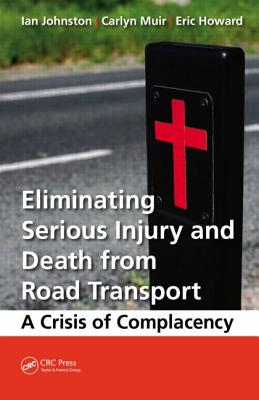The book explodes the myths that currently drive societys view of traffic safety and limit progress in reducing death and serious injury. It presents current scientific knowledge in a non-technical way and draws parallels with other areas of public safety and public health. It uses examples from the media and from public policy debates to paint a clear picture of a flawed public policy approach and offers preventive medicine principles to take the field forward.
Listen: Ian Johnston busts the bad behavior myth.
Should we really accept road trauma as collateral damage from daily road use? Eliminating Serious Injury and Death from Road Transport: A Crisis of Complacency explores why societies and their elected leaders view traffic safety as a (relatively) minor problem. It examines the changes in the culture of road use that need to occur if this public health problem is to be effectively resolved.
- Examines why road use culture is ego-centric ("whats in it for me?") and why this blocks progress
- Explores current traffic safety measurement methods and demonstrates how they have underpinned our flawed approach
- Discusses the controversial issue of speed and speeding and shows how a new approach to speed management will be fundamental to transformational change
- Details a simple account of the concept of a "Safe System" (as now promoted by the WHO and the OECD) while exploring the failure to get beyond the principles to extensive implementation
The book dispels the myths that currently drive societies (misguided) view of traffic safetythe bad behavior myth and the official myth that everything that can be done is being doneand how these myths limit progress in reducing death and serious injury. It presents current scientific knowledge and draws parallels with other areas of public safety and health. The book draws on examples from the media and from public policy debates to paint a clear picture of a flawed public policy approach. It presents a model for a preventive medicine approach to traffic safety policy to get beyond an ego-centric culture to a communal safety culture.
Get Eliminating Serious Injury and Death from Road Transport by at the best price and quality guranteed only at Werezi Africa largest book ecommerce store. The book was published by Taylor & Francis Inc and it has pages. Enjoy Shopping Best Offers & Deals on books Online from Werezi - Receive at your doorstep - Fast Delivery - Secure mode of Payment
 Jacket, Women
Jacket, Women
 Woolend Jacket
Woolend Jacket
 Western denim
Western denim
 Mini Dresss
Mini Dresss
 Jacket, Women
Jacket, Women
 Woolend Jacket
Woolend Jacket
 Western denim
Western denim
 Mini Dresss
Mini Dresss
 Jacket, Women
Jacket, Women
 Woolend Jacket
Woolend Jacket
 Western denim
Western denim
 Mini Dresss
Mini Dresss
 Jacket, Women
Jacket, Women
 Woolend Jacket
Woolend Jacket
 Western denim
Western denim
 Mini Dresss
Mini Dresss
 Jacket, Women
Jacket, Women
 Woolend Jacket
Woolend Jacket
 Western denim
Western denim
 Mini Dresss
Mini Dresss






























































